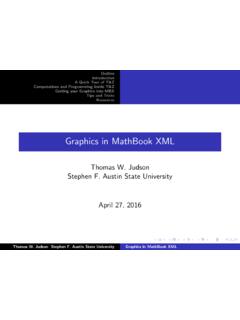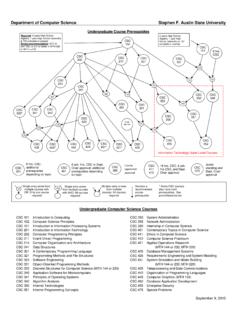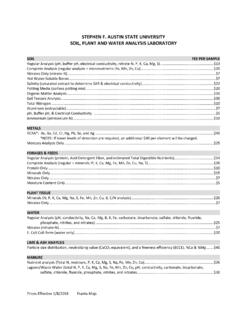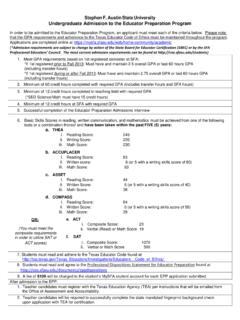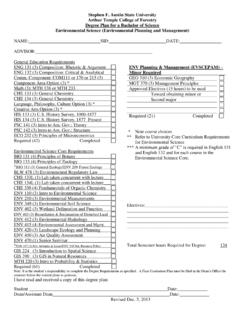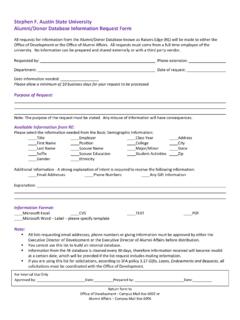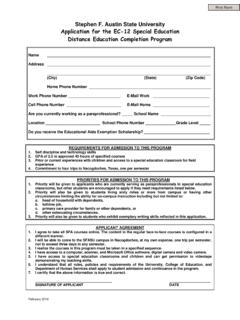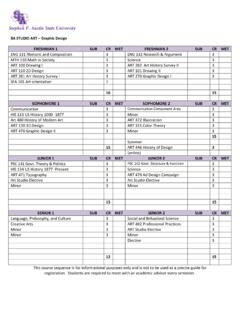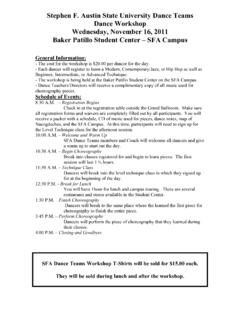Transcription of MEASURING TREE DIAMETERS - Forestry Home
1 Page 1 of 8 Adapted by the stephen F. austin State University Sylvans for use by the Association of Southern Forestry Clubs MEASURING tree DIAMETERS adapted from the TIMBER CRUISING HANDBOOK FSH United states Department of Agriculture Forest Service Washington, D. C. F. Dale Robertson, Chief Page 2 of 8 Adapted by the stephen F. austin State University Sylvans for use by the Association of Southern Forestry Clubs MEASURING tree Diameter Reading the Diameter Tape If the diameter reading is not exactly on a tenth, take diameter tape readings to the next lower one-tenth inch. This compensates for the positive bias incurred by MEASURING out-of-round trees with a tape. Figure 01, example A is read as , example B as , and example C as F i gu r e 01. D i a met e r t a p e mea su r em en t re a d i n g s. There are situations where diameter measurements are made and recorded to the nearest 1- or 2-inch diameter class.
2 This may occur when the precision of the MEASURING instrument can only be to the closest 1 or 2 inches or specified product volume estimation procedures are based on 1- or 2-inch DBH classes. Standard 1- and 2-inch classes are: 1. Examples of 1-inch diameter class are: 5-inch class = - inches; 9-inch class = - inches, and so on. 2. Examples of 2-inch diameter class are: 12-inch class = - inches; 14-inch class = - inches, and so on. There are situations where diameter measurements are not rounded. This situation occurs when absolute measurements are specified. Timber sale contract minimum tree DBH and minimum piece specifications are absolute. Example: 1. Minimum tree DBH specification = inches. This means would not be rounded to inches. 2. Minimum piece specification = inches DIB. This means would not be rounded up to inches.
3 Page 3 of 8 Adapted by the stephen F. austin State University Sylvans for use by the Association of Southern Forestry Clubs MEASURING tree Diameter at Breast Height (DBH) Measure DBH from the high ground side of the tree at feet above the forest floor (fig. 02a). If tree diameter cannot be measured at feet because of abnormalities, measure as described in section Leaning Trees. Measure DBH on leaning trees at a right angle to the center line of the tree as shown in figure 02b. Forked Trees. A forked tree is a tree with two or more stems originating from one stump. Consider forking to start at the point where daylight is seen. When a tree forks below feet, consider as two trees and measure DBH on each stem at feet above the ground on the high side (fig. 02c). If either stem at this point is abnormal, measure as described in section When a tree forks at or above feet, consider as one tree and record the smallest diameter at feet or below (fig.)
4 02d). Trees Growing Together. Two methods may be used to determine DBH on trees growing together. 1. If calipers are available, measure each tree at normal DBH point, feet above high ground side. 2. To use one-half diameter method, make two marks opposite each other on the stem at feet. Measure the distance between the marks with a diameter tape; double the measurement to determine DBH (fig. 02e). F i gu r e 02. M ea su r i n g D B H a ) a n o r ma l c a s e, b ) a l ea n i n g t r e e, c ) a fo r k o c c u r s b el o w 4 . 5 fe et , d ) a fo r k o c c u r s a b o v e 4 . 5 f ee t , a n d e ) t r e e s g r o wi n g t o g et h er . Page 4 of 8 Adapted by the stephen F. austin State University Sylvans for use by the Association of Southern Forestry Clubs Trees With Abnormalities at Feet.
5 Figure 03 illustrates examples of trees with abnormalities such as canker, swell, catface, or excessive branching. F i gu r e 0 3 . A b n o r ma l i t i e s a t 4 . 5 f e et . Use one of the following procedures when DBH measurement cannot be taken at feet: 1. If the tree can be measured at normally formed points above and below the abnormality, take measurements for "A" and "C" where tree exhibits normal taper and is free from influences of abnormality (fig. 04a). a. Measure diameter above DBH, point "A." b. Measure diameter below DBH, point "C." If these measurements are at equal distances from feet, average A and C to arrive at DBH measurement. Example: Diameter "A" = 16 inches Diameter "C" = 18 inches DBH = (16 + 18) / 2 = 17 inches If point A and point C are at unequal distances from feet, interpolate the distances to arrive at DBH measurement.
6 Example: Diameter "A" = 16 inches Diameter "C" = 22 inches Height of "A" above ground = 12 feet Height of "C" above ground = 2 feet Normal taper = (22" - 16") / (12 - 2 ) = inches/foot DBH = 22" - [( ' - 2') x "/ft.] = inches, or DBH = 16" + [(12' - ') x "/ft.] = inches Page 5 of 8 Adapted by the stephen F. austin State University Sylvans for use by the Association of Southern Forestry Clubs 2. If the tree cannot be measured at normal points above and below the abnormality, measure above the abnormality and apply taper from comparable trees of the same species (figure 04b). a. Measure diameter above DBH where shape is normal, point "A." b. Measure height to point "A," length "B." c. Determine average taper from comparable trees of the same species in immediate area. d. Interpolate DBH measurement "C" based on diameter measurement "A," the estimated average taper, and length "B.
7 " Example: Diameter "A" = inches Length "B" = 12 feet Estimated taper = 2 inches in 8 feet or .25 inches per foot DBH = 18 + ((12 - ) x .25) = inches or inches Trees Growing on Objects. When trees are growing on objects, such as rocks or logs, measure at feet above the root crown rather than above the forest floor. F i gu r e 0 4 . Te c h n i q u e s fo r d et er mi n i n g D B H wh en t r e e s a ) h a ve a b n o r ma l i t i e s a t 4 . 5 f e et , b ) h a v e a b n o r ma l b u t t sw el l , o r c ) a r e g r o wi n g o n o b j e c t s su c h a s r o c k s o r l o g s. Coppice Growth. To measure DBH on coppice growth or on trees growing in clumps, follow the procedures described in section - Broken Trees. Use one of the following procedures to determine DBH on broken trees: 1.
8 If DBH occurs either below the break (A) or above the break (C), measure normally using calipers or diameter tape (fig. 05a). 2. If DBH occurs at the break (B) as shown in figure 05a, use procedures outlined in section Broken Off Trees. Use one of the following procedures for determining DBH on broken off trees. Figure 05b illustrates these procedures. 1. If DBH occurs below the break (A), measure normally using calipers or diameter tape. 2. If DBH occurs at the break (B), and if bole is not shattered badly, make the DBH measurement at the break point. If bole is shattered, use procedures in section Page 6 of 8 Adapted by the stephen F. austin State University Sylvans for use by the Association of Southern Forestry Clubs 3. If DBH occurs above the break (C), measure normally using calipers or diameter tape. If necessary, dig under bole, to pass the tape through.
9 Down Trees. On down trees measure DBH at feet above original high side ground line at right angles to the center line of the bole (B) as shown in figure 05c. Measure normally using calipers or diameter tape. If necessary, dig under bole, to pass the tape through. F i gu r e 0 5 . M ea su r i n g D B H o n , a ) a b r o k en t r e e, b ) a b r o k en o ff t r ee, a n d c ) a d o wn t r ee . Page 7 of 8 Adapted by the stephen F. austin State University Sylvans for use by the Association of Southern Forestry Clubs Severed, Down Trees. Measure from the ground on the high side to the saw cut on the stump (AB) and then from the saw cut on the end of the log up the bole (BC) to determine where feet above the ground would be (fig. 06). Measure diameter at this point, normally using calipers or diameter tape.
10 If necessary, dig under bole, to pass the tape through. F i gu r e 0 6 . M ea su r i n g D B H o n se v er ed, d o wn tr e e s. Split Trees. Measure DBH with calipers or use the one-half diameter technique described in section F i gu r e 0 7 . M ea su r i n g D B H o n sp l i t tr ee s. Page 8 of 8 Adapted by the stephen F. austin State University Sylvans for use by the Association of Southern Forestry Clubs Trees Having a Large Catface. Use the most appropriate of the following procedures when MEASURING trees abnormally formed by a catface at feet: 1. Use calipers. Measure DBH at right angle to catface. 2. Use a diameter tape. Adjust the tape to a normally rounded position to allow for the catface portion missing. If the tape is not adjusted but is pulled tight, the tape will be straight across the missing portion and the diameter read will be less than it should be (fig.)
